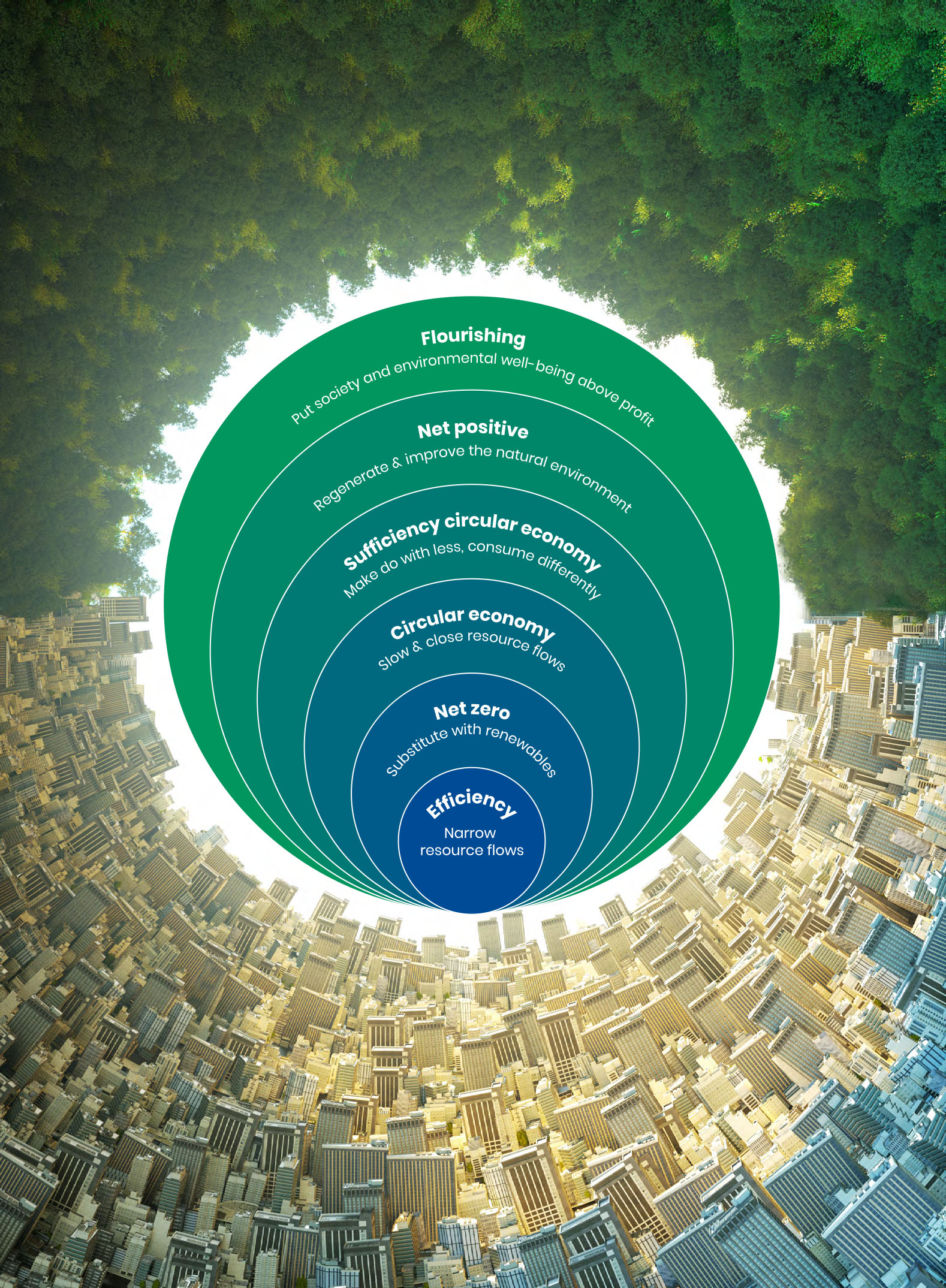Resource wisdom – The path to the core of responsible innovation
Author: Mika Patrakka
Estimated reading time: 7 minutes
Resource efficiency not only underpins eco-friendly business models but also fosters economic viability. A resource-wise approach considers even more broadly the use of renewable resources, the circular economy, well-being, and reduces dependence on limited natural resources. However, sustainable development demands various skills, rethinking, and actions from organizations.
Resource efficiency entails optimizing the use of resources such as raw materials, energy, and water in products, production, and services. The goal is to produce more with less, achieving greater value with lower resource consumption. This is not just an ecological choice but a strategic and economic decision that can lead to significant savings and even innovations.
Resource wisdom goes beyond resource efficiency, as the resource-efficient model aims to use only one resource at a time as efficiently as possible. It looks at resource consumption on a societal level to achieve the best overall outcome, as resource use affects the environment, society, and future generations.
To ensure vitality, radical innovations, such as technology that produces protein from the air, are needed,

Toward a new sustainable society (The Sufficiency-Based Circular Economy — An Analysis of 150 Companies, 2022)
Importance of resource wisdom for businesses
In today’s fast-paced and resource-limited world, the importance of resource wisdom becomes increasingly crucial even in machine and equipment manufacturing businesses. The benefits of resource wisdom include:
- Cost savings and efficiency: By using resources more efficiently, companies can reduce costs, especially for raw materials and energy. This can lead to significant savings and enhance a company’s competitiveness.
- Promoting innovation and competitive advantage: Focusing on resource efficiency encourages innovation in production processes and products. This helps companies differentiate themselves in the market and offer customers new and sustainable alternatives.
- Reducing environmental impacts: More efficient and wiser resource use reduces environmental burdens, which is crucial for mitigating climate change and ensuring sustainable use of natural resources.
- Enhancing responsibility and improving corporate reputation: Increasing awareness among customers and investors about environmental issues has put pressure on companies to act responsibly. Resource efficiency is an effective way to demonstrate commitment to sustainable development principles, not to mention resource wisdom.
From optimization to radical innovations
Resource efficiency often involves optimization, which means making things slightly better. However, significant challenges cannot be solved by doing a little; instead, a vision, desire, and ability to change the way of working and create something new are required. The best results are achieved when cause-and-effect dynamics are analyzed and the best course of action for the entire order-to-delivery chain is carefully weighed.
To ensure vitality, radical innovations, such as technology that produces protein from the air, are needed, as new economic models based on the circular economy and renewable economy require them. They can be risky, but they have the potential to create significant value and competitive advantage. It is also essential to remember that radical innovations require patience, and action must be taken immediately because the spread of innovation requires will, time, and resources!
Implementing resource efficiency in practice
To achieve effective resource management, companies need to assess their entire value chain. It is not enough to evaluate just one aspect; instead, all actors and practices in the value chain must be examined.
1. Start with value chain analysis.
By understanding where resource consumption is highest in the value chain, it is possible to identify areas where efficiency can be improved. Tools such as value stream mapping or GAP analysis can help with this. Productivity does not improve merely by adding resources; instead, a change in working methods enables productivity leaps by increasing value added in the input-output ratio. One of the Lean principles is waste elimination, and I think its importance is emphasized in resource efficiency.
2. Understand cause-and-effect relationships.
It is worth investing in understanding cause-and-effect relationships because saving resource in one place can easily mean wastage in another. This can be approached and reflected, for example, by considering:
- What changes need to be made in different parts of the supply chain?
- What requirements does it create?
- What new approach does it require?
3. Leverage technology.
Modern technology, such as artificial intelligence, increases efficiency and reduces resource use. Efficient resource development is, in fact, the most demanding work because the goal is to manage with as few resources and operations as possible. There are also technologies, such as additive manufacturing, that enable completely new shapes and structures to be achieved, resulting in almost no material waste.
4. Build collaboration and partnerships.
Collaboration with suppliers and other stakeholders can help find more sustainable solutions and promote common resource efficiency goals. By leveraging the by-products of the circular economy, significant savings can be achieved both in production and mineral extraction, to mention an example.
5. Continuously monitor and evaluate the results.
Promoting resource efficiency is a continuous process that requires regular monitoring and evaluation of operations. Continuous improvement and an open and curious attitude enable finding new ways.
Tools, rethinking, and courage towards wise solutions
Pursuing an ideal solution does not mean that a perfect solution is always achievable. Instead, it serves as a good guideline and motivator, encouraging creative thinking. At the core of innovation activities is solving problems in a way that meets all needs without compromise or negative side effects. Identifying conflicts is important to keep in mind all the time, and only examining cause-and-effect relationships enables the creation of resource-wise and sustainable solutions.
Lifecycle thinking must be considered throughout product development, from raw material procurement to manufacturing, use, and finally recycling or disposal. This approach helps identify all stages where resources can be used more efficiently.
Ecological design and design methods help focus on minimizing the environmental impacts of products. This may include material efficiency, energy efficiency in production and during use, and considering the longevity and repairability of products. Similarly, it is good to use design methods that support resource efficiency, such as Design Thinking or the TRIZ method.
Modular and sustainable design produces modular products, making it easy to repair or replace parts without replacing the entire product. Sustainable design also includes choices that extend the product’s lifespan and reduce its environmental impacts.
The use of renewable materials should be explored, utilizing more sustainable materials that can reduce environmental impacts or improve resource efficiency. This may include recycled or renewable materials.
Managing cause-and-effect relationships is emphasized, and the goal is to understand how different factors affect each other and outcomes to make better decisions and manage risks more effectively. When aiming to develop products in line with sustainable development, it is important to strive for a comprehensive view. Several conflicts are easily encountered in the examination, which, when solved, result in sustainable solutions.
Resource-wise development brings true benefits
It is easy to create complex products or heavy processes that consume resources because their design doesn’t require much creativity. However, the mindset of “everything is always available and we settle for the first ideas” distances us from creativity. Therefore, investment in innovation thinking is essential. We must be able to search for ideal solutions to real problems and goals with minimal resources.
Multiple actions and approaches are needed to integrate resource efficiency into product development to ensure that products are designed and manufactured with minimal environmental impact and resource use. The benefits attainable are significant: real environmental and societal well-being and a regenerative and flourishing future.
Differences between TRIZ and Design Thinking methods – both are needed at the same time
Both the TRIZ and Design Thinking methodologies emphasize precise problem definition before seeking solutions. This helps ensure that solutions are targeted and effective – only what produces real value and is meaningful is done.
One essential and fundamental assumption of the TRIZ method is that most problems are rooted in fundamental contradictions: for example, a structure must be strong but lightweight. In other words, strengthening the product structure may increase its weight, which is undesirable. Therefore, the willingness to solve problems should emphasize the need to address these contradictions.
While Design Thinking starts from the same premises as the TRIZ method, the difference lies in that TRIZ emphasizes technology more, whereas Design Thinking starts from the needs of the user or customer. Design Thinking thus emphasizes user-centeredness and business, aiming to understand and consider user needs and experiences to achieve sustainable business.

Mika Patrakka
MBA, Industrial Designer
Mika works as a Business Development Manager in the Machinery and Equipment business unit. He has more than 10 years of experience in various roles in design, development and management. Mika promotes sustainable growth and the development of products and services and helps companies create circular economy-based business and strategies. His development philosophy is guided by the growth mindset and customer experience, and he utilizes service design and agile methods in his work.
mika.patrakka@elomatic.com
Want to know more? Check out these related articles:
Resource efficiency
Would you like to boost the resource efficiency of your operations? We design efficient production plants and processes and improve the operational efficiency of energy and materials.
Water wisdom – often overlooked aspect of industrial circular economy
The adequacy of clean water has been identified as one of the key risks in our society, along with climate change and the decline of biodiversity. Therefore, it is important for us to consider water wisdom as a significant part of our journey towards a more sustainable future within the context of the circular economy.
